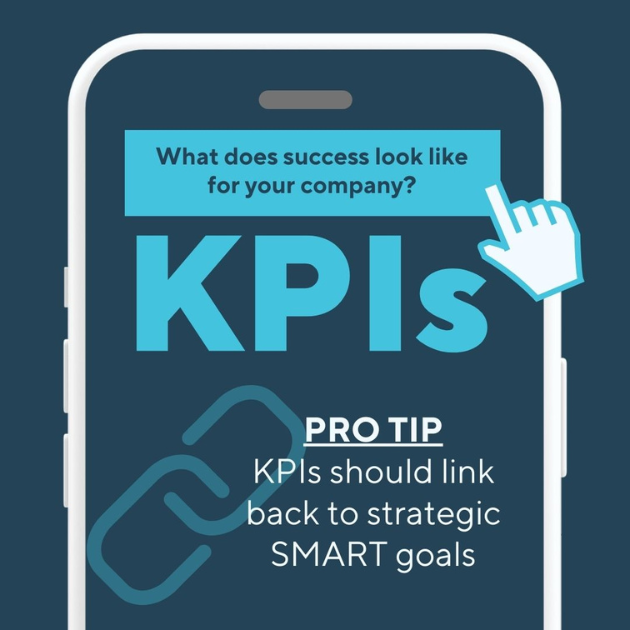KPI seems to be the latest buzzword making its way across boardrooms and project updates. Maybe it’s because budgets are being more heavily scrutinized so marketers feel they need to prove the value of every spend. Maybe it’s because more people are still working remotely so we now live in a land of shareable dashboards. Maybe it’s that the digital tools we are using seem a bit savvier with the recent AI push. Hopefully, it is because business leaders are looking to amp up their game and are planning to use KPIs to create their playbook.
Key performance indicators (KPIs) can be a lot of things, including strategic, operations-focused, company-wide, department/division-specific, looking back or predictive. What they are not is a one-size-fits-all method of reporting wins. Strategic marketing goals, business objectives, timelines and audience targets are unique, so pulling a set of KPIs off the web will be neither key nor indicative for your company. Instead, your company’s KPIs should be, like it says, key to your company. And, setting a company’s KPIs should not be something done once and then forgotten. Just as your company goals change, so should your KPIs. So, where should you start? Here are some suggestions.

Setting Your KPIs
First, take a look at your organization and its needs. How do people use information? If your team receives monthly reporting and never spends the time to review it or it doesn’t offer any value to them when they do view it, consider keeping your KPIs clean and simple and present them in a highly visual, 5-minute review format. On the other hand, if your team lives for the four-mile-long spreadsheet delivered to their inbox each month that shows every cent won and lost, your KPIs can likely be more complex and presented with a greater depth of data.
Second, and this is the most important step, pull out your strategic goals, likely for the upcoming quarter. Assuming you have SMART (Specific, Measurable, Attainable, Realistic, and Time Specific) goals that you are working toward, your KPIs should pair with these deadline and quantitative goals. Reminder: not everything can be key, so you should keep your list of KPIs to a reasonable amount.
Third, determine how you will consistently track these identified KPIs. Note, you must be able to track each KPI over time using the same method to get a clear picture of trending. Then, determine how you wish to show and share these performance indicators and how often (i.e. monthly, quarterly, or yearly).
Finally, and here is the step often forgotten, decide who will take ownership of managing actions based on KPI outcomes. For example, often we see trends sliding downward indicating action is needed. A champion needs to be assigned to get the ball rolling on adjusting your goals and KPIs or evaluating what action needs to be taken to improve performance quickly.
Other KPI Methods
If you are so focused on day-to-day operations that you don’t have time for big-picture thinking, build time in your schedule immediately, but in the meantime, you can set operational KPIs. These usually focus on sales pipeline or customer engagement data. For example, you could monitor the number of meetings set per week, the number of bids submitted, the number of new sales per month, total sales revenue or satisfactory customer service surveys. Many of these KPIs come pre-baked into tools such as HubSpot. You can also focus on engagement factors such as open rates on emails, surveys completed, and social media likes and followers.
More than Win and Loss Reporting
Qlik, a company that works in complex data landscapes to bring about strategic outcomes for businesses, suggests using a mix of lagging indicators and leading indicators in KPI planning. A lagging indicator shows you what happened in the past but a leading indicator can help you make educated predictions on what could happen. For example, a lagging indicator might be the percentage of users who clicked a button on an online ad campaign in the past quarter. A leading or predictive indicator might be a decline in the number of mobile users on your sites last quarter, for example, which could significantly impact your plan to launch a mobile product training academy next quarter.
Investopedia illustrates this difference, noting that leading indicators help you forecast or predict future movements and actions while lagging indicators show you the results of what happened based on your previous actions. Considering your KPI data in both such manners can help you be more strategic in your marketing communications planning, from selecting the channels to use to deciding which content generation activities you commit time, talent and spend t
Key Takeaways
- Change how you look at and use KPIs (and your general reporting) to make these efforts more about informing your future actions and seeing the impact your efforts made versus only showing wins to justify the spending.
- Company A’s KPI will not be the same as Company B’s, even if they are in the same industry, geographic market, etc.
- Link KPIs to your strategic planning and SMART goals.
- Re-evaluate your KPIs quarterly to see if other indicators are more key to your organization today.
- Avoid KPI overload, especially if too much data makes your team delete your emails. Be brief, specific and visually display data when possible. Consider making your KPIs fit on a single page so a viewer can get a good feel for what’s happening in 5 minutes or less.
- Be consistent with your KPI reporting. This is big. Four people can show a key piece of data in four different ways. Make sure you track KPIs using the same method, over the same period, no matter who generates the reporting.
Need help crafting your KPIs and determining your next steps based on these indicators? Call the Foster Marketing team today at 281-448-3435 or contact us via our website.
